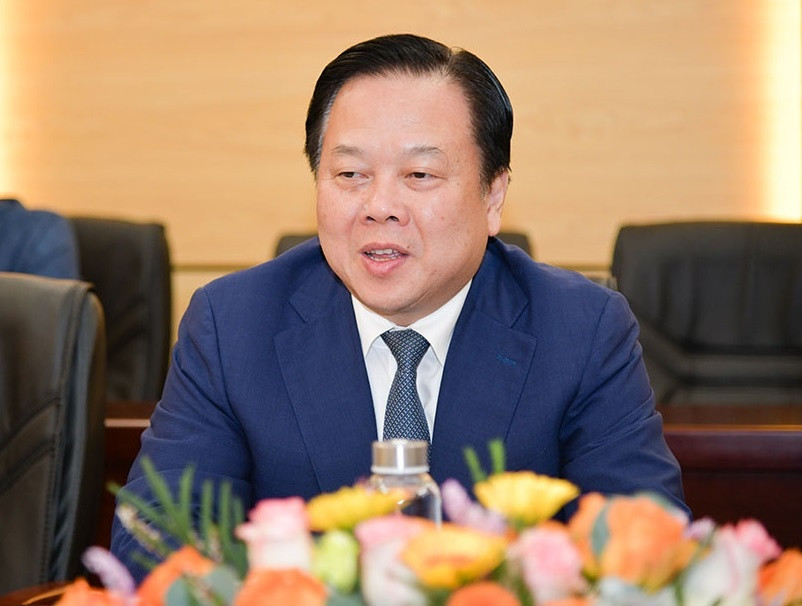In the challenging past 12 months or so, how did state-owned enterprises (SOEs) under the Commission for the Management of State Capital at Enterprises perform and recover?
In 2022, some SOEs under the commission had a sharp decrease in profit. Some even suffered losses, and their equity reduced.
 |
| Nguyen Hoang Anh, chairman of the Commission for the Management of State Capital at Enterprises |
Despite the difficulties, SOEs have made efforts to overcome and recover, contributing to the national socioeconomic development, state budget collection, and macroeconomic stabilisation, thus demonstrating their key role in a number of fields. In general, they fulfilled their business yearly targets and tasks.
Total revenues of 19 SOEs are estimated at $48.82 trillion, surpassing the yearly target by 14 per cent and rising 33 per cent from 2021. As many as 15 out of 19 SOEs fulfilled or surpassed the yearly revenue targets; 17 fulfilled or exceeded the yearly pre-tax profit targets; 16 fulfilled or surpassed the yearly state budget contribution targets. Some like PetroVietnam, Petrolimex, Vinachem, Vinacomin, and Vietnam Expressway Corporation improved performance compared to 2021.
Disbursement of public investment is a key issue that the government always wants to boost. How did SOEs do this during 2022?
After four years of being managed by the commission, they have implemented and completed as many as 41 projects under Group A and 125 others under Group B.
Based on their ideas, the commission has reported to the government and the prime minister and relevant authorised agencies to remove obstacles in terms of mechanisms, policies, and laws to enable them to implement many projects. They included the 10 key projects which were in slow progress for years with a total investment of about $11.26 billion.
In 2022, disbursement of investment among most of the SOEs was slower than expected because they had to focus their resources on overcoming the impact of the pandemic.
Last year, they implemented a number of projects. For instance, in the energy industry, Electricity of Vietnam made total investments of an estimated $3.93 billion, or 87 per cent of the yearly target. PetroVietnam made estimated investment of $1.19 billion. Vinacomin had total investment of $513.5 million.
Elsewhere, in the transport sector, SOEs focused on key projects such as Long Thanh International Airport, the North-South Expressway, and others. Specifically, Airports Corporation of Vietnam is estimated to disburse total investment capital of about $460 million.
What are the commission’s orientation and key tasks in 2023 to better support state-owned groups in their development, and to increase operational efficiency?
It will continue to synchronously implement solutions to further support them and corporations in their production and business activities, thus maintaining their role as the core force of the economy, creating a driving force for the national economic development and carrying out political tasks assigned by the state. The commission will check and collect their ideas and proposals and then propose them to authorised agencies to solve their difficulties, promote administrative reform, and improve the business climate to facilitate their recovery and development.
Measures and solutions will be taken to increase productivity and competitiveness of the SOEs, efficiency of equitisation and state stake divestment; speed up digital transformation, and promote green growth and circular economy in line with a proper roadmap; and increase efficiency of public investment disbursement to fast-track the process of key projects. The other focus will be the direction to the SOEs to quicken the building of their development strategies, and important plans before submitting them to authorised agencies for approval and implementation.
How do you evaluate the model of a representative agency of state capital owners investing in enterprises after four years of operation, and what have been the gains?
On the basis of theoretical research and practical summaries, our Party has had many oriented policies on reorganising, renovating, developing, and improving the operational efficiency of SOEs, including renewing the model of exercising the right to represent the owner of state capital in the enterprises.
Before the establishment of the commission, ministries and provinces both performed the function of state management and acted as the representative of the state owner in the enterprises. However, along with the process of socioeconomic development associated with deep international integration, this method revealed some shortcomings. For example, the lack of separation between policy issuance and business management created an unequal and unfair environment for all business sectors. And overburdened ministries affected the quality of policymaking to improve the business environment and contribute to perfecting the socialist-oriented market economy institution.
To solve this problem, the solution is separating the function of owner of state capital and assets and the function of state management for SOEs, and abolishing the function of representing the owner for state capital and assets in enterprises from ministries and localities.
As a result, the commission was established in 2018, managing 19 state-owned corporations (formerly under five ministries) with a total equity making up 63 per cent and total assets accounting for over 65 per cent of the country’s SOEs. Since then, the establishment of the commission has brought about good results as it helps increase efficiency of state management, and operational efficiency of the 19 SOEs in 16 key sectors and industries. Specifically, it solved sluggish projects and less-efficient businesses in the trade and industry sector, and strictly supervised restructuring, equitisation, and state stake divestment.
A number of projects had their problems solved. They included the 10 major projects which faced sluggishness for years with a total investment of $11.26 billion. They were the oil and gas exploration and production project at four blocks in the Nhenhexky region of Russia; the Hoa Binh power plant expansion project; the expansion of Ialy power plant; and the component project 3 of Long Thanh airport, among others.
To further increase its operational efficiency, its power and responsibility should be soon completed and perfected to make it more in line with the actual conditions of the commission and the relevant legal system.
Source: VIR